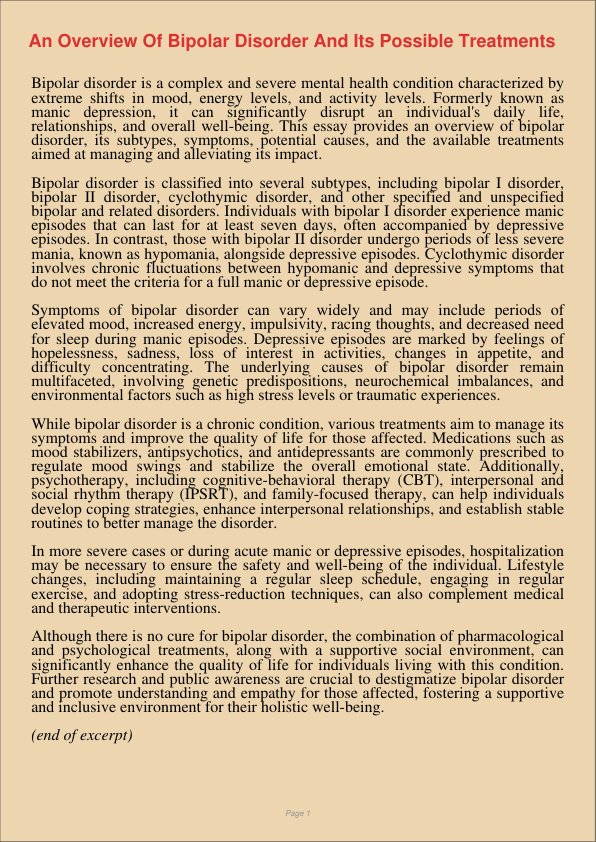An Overview Of Bipolar Disorder And Its Possible Treatments
Dec 31, 2023
possible treatments
bipolar disorder
Engineering and Construction
History
Bipolar disorder is a complex and severe mental health condition characterized by extreme shifts in mood, energy levels, and activity levels. Formerly known as manic depression, it can significantly disrupt an individual’s daily life, relationships, and overall well-being. This essay provides an overview of bipolar disorder, its subtypes, symptoms, potential causes, and the available treatments aimed at managing and alleviating its impact.
Bipolar disorder is classified into several subtypes, including bipolar I disorder, bipolar II disorder, cyclothymic disorder, and other specified and unspecified bipolar and related disorders. Individuals with bipolar I disorder experience manic episodes that can last for at least seven days, often accompanied by depressive episodes. In contrast, those with bipolar II disorder undergo periods of less severe mania, known as hypomania, alongside depressive episodes. Cyclothymic disorder involves chronic fluctuations between hypomanic and depressive symptoms that do not meet the criteria for a full manic or depressive episode.
Symptoms of bipolar disorder can vary widely and may include periods of elevated mood, increased energy, impulsivity, racing thoughts, and decreased need for sleep during manic episodes. Depressive episodes are marked by feelings of hopelessness, sadness, loss of interest in activities, changes in appetite, and difficulty concentrating. The underlying causes of bipolar disorder remain multifaceted, involving genetic predispositions, neurochemical imbalances, and environmental factors such as high stress levels or traumatic experiences.
While bipolar disorder is a chronic condition, various treatments aim to manage its symptoms and improve the quality of life for those affected. Medications such as mood stabilizers, antipsychotics, and antidepressants are commonly prescribed to regulate mood swings and stabilize the overall emotional state. Additionally, psychotherapy, including cognitive-behavioral therapy (CBT), interpersonal and social rhythm therapy (IPSRT), and family-focused therapy, can help individuals develop coping strategies, enhance interpersonal relationships, and establish stable routines to better manage the disorder.
In more severe cases or during acute manic or depressive episodes, hospitalization may be necessary to ensure the safety and well-being of the individual. Lifestyle changes, including maintaining a regular sleep schedule, engaging in regular exercise, and adopting stress-reduction techniques, can also complement medical and therapeutic interventions.
Although there is no cure for bipolar disorder, the combination of pharmacological and psychological treatments, along with a supportive social environment, can significantly enhance the quality of life for individuals living with this condition. Further research and public awareness are crucial to destigmatize bipolar disorder and promote understanding and empathy for those affected, fostering a supportive and inclusive environment for their holistic well-being.
